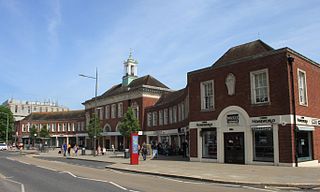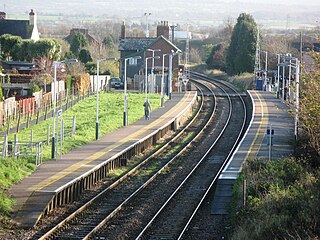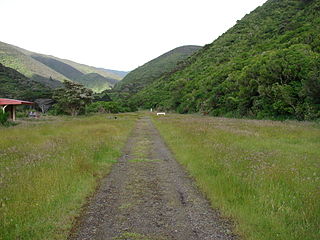
Yeovil Junction railway station is the busier, but less central, of two railway stations serving the town of Yeovil in England. The station is 2 miles (3.2 km) outside the town, in the village of Stoford. Although Yeovil is in Somerset, the station was in Dorset until 1991. It is 122 miles 48 chains (197.3 km) down the line from London Waterloo.

The West of England line is a British railway line from Basingstoke, Hampshire, to Exeter St David's in Devon, England. Passenger services run between London Waterloo station and Exeter; the line intersects with the Wessex Main Line at Salisbury. Despite its historic title, it is not today's principal route from London to the West of England: Exeter and everywhere further west are reached more quickly from London Paddington via the Reading–Taunton line.

The Avocet Line is the railway line in Devon, England connecting Exeter with Exmouth. It was originally built by the London and South Western Railway, and was historically known as the Exmouth branch railway. The line follows the Exe Estuary for about half of its route, from just outside Topsham to Exmouth, giving views of the estuary. The line is named after the pied avocet, which lives in the estuary.

Ipswich railway station is on the Great Eastern Main Line in the East of England, serving the town of Ipswich, Suffolk. It is 68 miles 59 chains (110.6 km) down the line from London Liverpool Street and, on the main line, it is situated between Manningtree to the south and Needham Market to the north.

Exeter Central railway station is the most central of the stations in the city of Exeter, Devon, United Kingdom. It is 171 miles 30 chains (275.8 km) down the line from London Waterloo. The station is smaller than Exeter St Davids on the west side of the city. Great Western Railway manages the station and operates most services, as well as South Western Railway.

St James Park railway station is a suburban railway station in Exeter, Devon, England. It is 170 miles 72 chains (275.0 km) down the line from London Waterloo. The station is adjacent to the Exeter City football ground. Great Western Railway manage the station and operate the train services.

Polsloe Bridge railway station is a suburban railway station in Exeter, Devon, England. The station serves the Polsloe, Mount Pleasant, Hamlin and Whipton areas of the city.

Pinhoe railway station is on the eastern edge of the city of Exeter in Devon, England, that serves the village of Pinhoe. It was opened by the London and South Western Railway (LSWR) in 1871 but is now operated by South Western Railway which provides services on the West of England Main Line. It is 168 miles 44 chains (271.3 km) down the line from London Waterloo.

Newton Abbot railway station serves the town of Newton Abbot in Devon, England. It is 214 miles 5 chains measured from the zero point at London Paddington via Box, at the junction for the branch to Paignton. The station today is managed by Great Western Railway, who provide the train service along with CrossCountry.

Templecombe railway station serves the town of Templecombe in Somerset, England. It is situated on the West of England Main Line, 112 miles 2 chains (180.3 km) down the line from London Waterloo. The main station opened in 1860 but a smaller station on the lower line opened in 1862. It was closed in 1966 but was reopened in 1983 following local community pressure. It is currently operated by South Western Railway.

Salisbury railway station serves the city of Salisbury in Wiltshire, England. It is 83 miles 43 chains (134.4 km) from London Waterloo on the West of England line to Exeter St Davids. This is crossed by the Wessex Main Line from Bristol Temple Meads to Southampton Central. The station is operated and served by South Western Railway (SWR), and is also served by Great Western Railway (GWR).

Laira T&RSMD is a railway Traction & Rolling Stock Maintenance Depot situated in Plymouth, Devon, England. The depot is operated by Great Western Railway and is mainly concerned with the overhaul and daily servicing of their fleet of High Speed Trains and also the DMUs used on local services. The depot code "LA" is used to identify rolling stock based there.

Penzance TMD, also known as Long Rock TMD, is a railway Traction Maintenance Depot situated in the village of Long Rock east of Penzance, Cornwall, England, and is the most westerly and southerly rail depot in the country. The depot operator is Great Western Railway. The depot code is PZ.

Benalla railway station is located on the North East line in Victoria, Australia. It serves the town of Benalla, and it opened on 18 August 1873.

The Ilfracombe branch of the London & South Western Railway (LSWR), ran between Barnstaple and Ilfracombe in North Devon. The branch opened as a single-track line in 1874, but was sufficiently popular that it needed to be upgraded to double-track in 1889.

Cross Creek railway station was the base of operations for the Rimutaka Incline, a Fell railway over the Remutaka Ranges, and part of the original Wairarapa Line between Upper Hutt and Featherston in the Wellington region of New Zealand's North Island. The station was between Pigeon Bush and Summit stations on the Wairarapa Line. The station was bypassed when the Rimutaka Tunnel was opened.

Plymouth Friary railway station was the London and South Western Railway (LSWR) terminus in Plymouth, Devon, England.

Chard Junction railway station was situated on the London and South Western Railway’s West of England Main Line in Somerset, England. It was the junction of a short branch line to Chard. It was opened in 1860 as Chard Road and closed in 1966. An adjacent milk depot was served by its own sidings from 1937 to 1980. A signal box remains to control Station Road level crossing and a passing loop on the long section of single track railway between Yeovil Junction and Pinhoe.

Chard Central railway station was the principal railway station in Chard, Somerset, England. It was opened in 1866 and closed in 1962, during which time it was known by three different names.
Pyewipe Junction engine shed was a motive power depot operated by the Great Eastern Railway (GER) located in Lincolnshire, England.





















